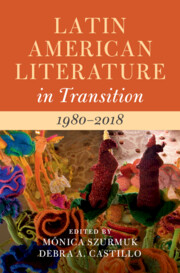Book contents
- Latin American Literature in Transition 1980–2018
- Latin American Literature in Transition
- Latin American Literature in Transition 1980–2018
- Copyright page
- Contents
- Contributors
- Acknowledgments
- Introduction
- Part I Security
- Part II New Genres
- Part III Mobilities
- Part IV Positionalities
- Part V Latin American Literature in Global Markets
- Chapter 22 Latin American Literature and Criticism in the Global Market
- Chapter 23 Memes in Brazilian Digital Culture
- Chapter 24 Mexican Transnational Cinema in the Twenty-First Century
- Index
- References
Chapter 23 - Memes in Brazilian Digital Culture
from Part V - Latin American Literature in Global Markets
Published online by Cambridge University Press: 24 November 2022
- Latin American Literature in Transition 1980–2018
- Latin American Literature in Transition
- Latin American Literature in Transition 1980–2018
- Copyright page
- Contents
- Contributors
- Acknowledgments
- Introduction
- Part I Security
- Part II New Genres
- Part III Mobilities
- Part IV Positionalities
- Part V Latin American Literature in Global Markets
- Chapter 22 Latin American Literature and Criticism in the Global Market
- Chapter 23 Memes in Brazilian Digital Culture
- Chapter 24 Mexican Transnational Cinema in the Twenty-First Century
- Index
- References
Summary
This chapter demonstrates an approach to studying digital culture within Brazilian cultural studies that both plays to the existing repertoires of scholars in this area and incorporates the agilities and sensitivities required to do justice to digital culture. It presents a case study of the famous Brazilian internet meme “Cala boca Galvão” of 2010, a joke played by Brazilian internet users at the expense of foreigners, which mushroomed from a catchphrase shared on Twitter during the FIFA World Cup, protesting the verbosity of well-known television presenter Galvão Bueno, into a spoof fundraising campaign to save an endangered parrot in the Amazon. Adopting and adapting a framework put forward by Brian T. Edwards, the chapter analyzes the “meaning,” or content, of the meme (a dispersed collection of texts) and its “movement,” or circulation, revealing how both touch on issues of national identity (including the ongoing importance of television) and the relationship between Brazil and the world. The chapter argues that the continued reverberation and sedimentation of “Cala boca Galvão” and the proliferation of memes emerging on a daily basis in Brazil make digital culture – and the intersections between it and other cultural arenas – essential topics for research in Brazilian cultural studies.
- Type
- Chapter
- Information
- Latin American Literature in Transition 1980–2018 , pp. 356 - 371Publisher: Cambridge University PressPrint publication year: 2022

